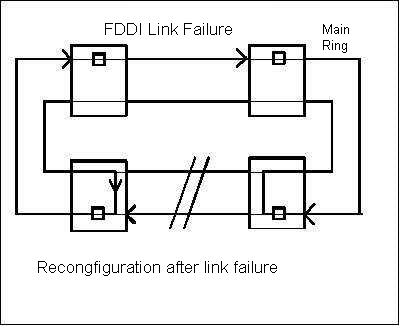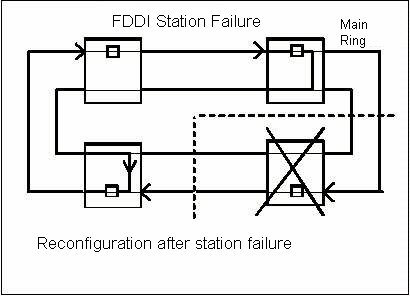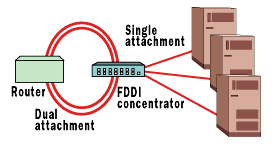
Group : William Pitt, Donald MacDonald, Angus Macfarlane
FDDI stands for Fibre Distributed Data Interface. It is a data transmission standard for high speed fibre optic token dual-ring local are networks. Such FDDI networks allow up to 500 nodes to be connected with a maximum ring-size of 124 miles and a 100 Mbit/s data transmission rate. Such FDDI technology is replacing slower 10 Mbit/s Ethernet Networks where higher data throughput is required and is often used for interconnecting LANs in backbone solutions.
The FDDI specification standards were developed by
committee X3T9.5 of ANSI (The American National Standards Institute) in
the early 1980s. It was developed to serve as an integrated voice/data
(Shared Media) LAN with the following features :
FDDI networks also implements the token ring mechanism where all of the stations are connected in a ring or star topology and a token-passing scheme is used to prevent collisions. This network method involves empty information frames being continuously circulated round the ring. When a station on the network has a message to send, it inserts a token, the message and a destination identifier into an empty frame. The frame is then checked by each successive station to see if it is the intended destination for the message. If so, the station copies the message from the frame and changes the token value from 1 to 0. When the frame gets back to the message sending station, it checks that the message has been received by checking it's token value. If set to 0, the station removes the message from the frame. The frame then continues round the network as an empty frame, ready to be used by any network station that has a message to send. This token ring technique prevents collisions between stations sending messages simultaneously.
In fact, FDDI networks contain two token rings - the primary and secondary ring. This strategy, called the dual counter-rotating ring concept, provides a backup line in case of station failure or a line break. Two rings are connected to each station, with one ring transmitting clockwise and the other one transmitting counter-clockwise. This set of dual rings is referred to as the trunk ring. Such a trunk ring provides a redundant path so that the ring remains functional in the event of any single failure.

If a link or a station fails, the stations on either side of the fault reconfigure internally connecting the rings to provide a loopback path.

However, one limitation of this dual counter-rotating ring design is that if two faults occur, the ring is broken in two places, effectively creating two separate rings. This problem can be circumvented by providing for concentrators (which I discuss later) on the dual ring. When the network is in operation, as already stated, one of the rings may simply be designated as a standby ring only, or it may be used for concurrent transmission. Thus it is possible to have data flowing on both channels for an aggregate throughput of 200 Mbit/s. However the FDDI specification does not recommend this.
The FDDI standard consists of the following four layers :
The FDDI standard specification defines and uses the following four station types :
 An
FDDI Concentrator is a type of node with multiple ports into which single
attachment stations connect. Concentrators may be capable of directly attaching
to the trunk ring (DAC), single ring only (SAC), or form the root of a
tree (a Null Attachment Concentrator - NAC). The benefit of using Concentrators
in FDDI networks is that they isolate failures at end stations so that
the damage to the network as a whole is limited. Another advantage of concentrators
is that nodes can be powered on and off without disrupting ring integrity.
Concentrators make FDDI networks more reliable and also provide SNMP (Simple
Network Management Protocol) management functions. Most FDDI networks are
now built with Concentrators.
An
FDDI Concentrator is a type of node with multiple ports into which single
attachment stations connect. Concentrators may be capable of directly attaching
to the trunk ring (DAC), single ring only (SAC), or form the root of a
tree (a Null Attachment Concentrator - NAC). The benefit of using Concentrators
in FDDI networks is that they isolate failures at end stations so that
the damage to the network as a whole is limited. Another advantage of concentrators
is that nodes can be powered on and off without disrupting ring integrity.
Concentrators make FDDI networks more reliable and also provide SNMP (Simple
Network Management Protocol) management functions. Most FDDI networks are
now built with Concentrators.
This FDDI technology specifically defines the networking components required to conform to industry standards. Along with the fibre optic cable and the basic dual ring topology, the standard defines specific devices used in the network. From those definitions, vendors produce standard-compliant concentrators, bridges, and controllers for stations attached to the FDDI network.
REFERENCES
- Data Communications - A Comprehensive Approach - 3rd Edition
- Gil Held & Ray Sarch
- Local Area Networks - Gerd E Keiser
- FDDI - A High Speed Network - Amit Shah & G Ramakrishnan
- http://www.avsysltd.com/brochures/FDDI.html
- http://www.gt.ktk.se/doc/network/fddi.html
- http://whatis.com/fddi.htm
- http://data.com/Tutorials/FDDI_Fundamentals.html
- http://www.sunderland.ac.uk/~ts0jti/lans/fddi.htm
- http://auth.gr/authnet/index.html
- http://actpwww.cityu.edu.hk/network/12_fddi.htm